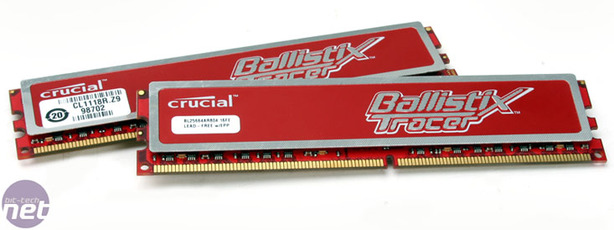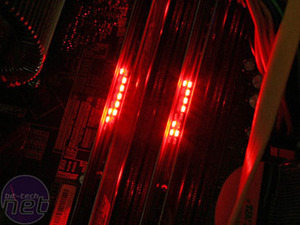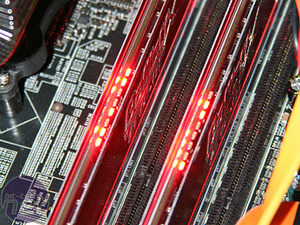Right in the middle along the top, there are sixteen red LEDs (eight on each edge) – these flash and chase each other in a combination that’s related to memory usage. It’s a strange effect and one that is far from intuitive to look at and easily understand.
While it will flash faster the heavier the memory load (not memory use), it’s not as quantifiable as it was with Corsair’s Pro series, which featured LEDs that went from green to yellow to red along the top. What does surprisingly look funky though is that Crucial puts LEDs along the bottom of its Ballistix Tracer modules as well, illuminating the memory slots.
Having seen the black version of the Ballistix Tracers before, I have to say I actually prefer them – they use white LEDs in the bottom instead of the red used here. The white LEDs do a better job of providing ambient light to the surrounding DIMM slots without saturating the whole area in one colour.
What does annoy us about the Crucial memory is that none of the codes on the DIMMs tell you what modules you bought, unlike every other stick of performance memory sold. For example, on every Corsair or OCZ memory you’ll get a sticker reading something along the lines of “800MHz 4-4-4-12 2.2V 2GB”. With Crucial, only the antistatic bag the DIMMs come in tells you what exactly they are!
I guess it’s time to go fish out that box from the bin, then! Thankfully this has changed with its DDR3 modules – the latest Ballistix we've received are labelled with details.
As a subdivision of Micron memory, the chips used inside are understandably Micron. Most other performance 4GB kits at the moment favour Prochip parts: at least this was the message we were hearing from many during CeBit. While we thought Crucial also used Prochip at first, given that its optimum voltage for overclocking falls within the same range, we were kindly informed by Crucial that this was a misconception.
For both Prochip and Micron 4GB sticks it seems too much voltage was a bad thing – we had initially tested at our usual 2.35V but the sticks capped out at just a 1,000MHz overclock. We dropped this down to 2.1V and found they would do a significantly better 1,142MHz instead. That’s PC-9136 speeds from PC-6400 memory!

EPP is also included, so those who use Nvidia boards will be able to set one setting and have everything else work itself out automatically. While we used EPP when we tested at stock speeds, we preferred to overclock the modules manually.
While it will flash faster the heavier the memory load (not memory use), it’s not as quantifiable as it was with Corsair’s Pro series, which featured LEDs that went from green to yellow to red along the top. What does surprisingly look funky though is that Crucial puts LEDs along the bottom of its Ballistix Tracer modules as well, illuminating the memory slots.
Having seen the black version of the Ballistix Tracers before, I have to say I actually prefer them – they use white LEDs in the bottom instead of the red used here. The white LEDs do a better job of providing ambient light to the surrounding DIMM slots without saturating the whole area in one colour.
What does annoy us about the Crucial memory is that none of the codes on the DIMMs tell you what modules you bought, unlike every other stick of performance memory sold. For example, on every Corsair or OCZ memory you’ll get a sticker reading something along the lines of “800MHz 4-4-4-12 2.2V 2GB”. With Crucial, only the antistatic bag the DIMMs come in tells you what exactly they are!
I guess it’s time to go fish out that box from the bin, then! Thankfully this has changed with its DDR3 modules – the latest Ballistix we've received are labelled with details.
As a subdivision of Micron memory, the chips used inside are understandably Micron. Most other performance 4GB kits at the moment favour Prochip parts: at least this was the message we were hearing from many during CeBit. While we thought Crucial also used Prochip at first, given that its optimum voltage for overclocking falls within the same range, we were kindly informed by Crucial that this was a misconception.
For both Prochip and Micron 4GB sticks it seems too much voltage was a bad thing – we had initially tested at our usual 2.35V but the sticks capped out at just a 1,000MHz overclock. We dropped this down to 2.1V and found they would do a significantly better 1,142MHz instead. That’s PC-9136 speeds from PC-6400 memory!

EPP is also included, so those who use Nvidia boards will be able to set one setting and have everything else work itself out automatically. While we used EPP when we tested at stock speeds, we preferred to overclock the modules manually.

MSI MPG Velox 100R Chassis Review
October 14 2021 | 15:04











Want to comment? Please log in.